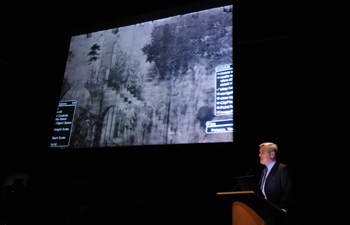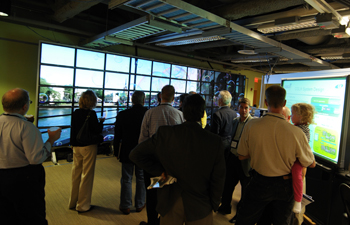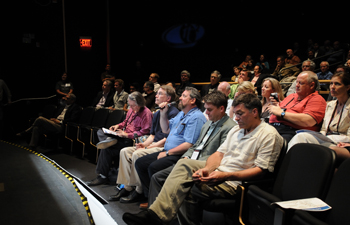Top Technology Industry Officials Visit Calit2 at UC San Diego During 'Future in Review' Conference
San Diego, CA, June 1, 2008-- Top officers from technology companies around the world converged on the UC San Diego division of Calit2 last week for a series of innovative demonstrations and a tour of the institute's high-tech facilities. The visit was part of this year's Future in Review (FiRe) workshop, dubbed "the best technology conference in the world" by The Economist magazine. [For a companion article about the FiRe CTO Challenge, click here .]
|
For the third year in a row, participants were invited to take a “field trip” to Atkinson Hall, the location of Calit2’s cutting-edge laboratories on the UCSD campus. This year’s collaboration with the FiRe conference is Calit2’s largest yet, said Calit2 Director Larry Smarr.
“The fact that the conference has adopted Calit2 as their ‘FiRe living laboratory of the future’ is a great honor. We were excited to share our vision of the future with so many leaders of industry and public policy,” explained Smarr.
|
The Calit2 event, which took place during the second evening of the conference, included a presentation by Italian art diagnostician and Calit2 researcher Maurizio Seracini; a visit to the gallery@calit2 to see an art exhibit about surveillance technology pre-9/11, titled “Exposure”; 3-D scientific visualizations in the StarCAVE 360-degree, virtual-reality system; a demonstration of several versions of Gizmo – a toy-sized remote-controlled truck that serve as a “research platform on wheels” to deploy different CalMesh technologies for disaster response and other emergencies; and a chance to see the world’s largest tiled wall display exhibiting images with resolutions of hundreds of millions of pixels. The HIPerSpace wall has a screen resolution up to 220 million pixels, and networked to a 200 million pixel system in the Calit2 Building at UC Irvine, the combined system can deliver real-time rendered graphics simultaneously across 420 million pixels to audiences in Irvine and San Diego .
|
With his data streaming remotely from Seattle, Curtis Wong, Principal Researcher and Group Manager for Next Media Research at Microsoft, led a rapt audience through a multi-spectral, virtual tour of the stunning images from earth and space telescopes, part of Microsoft's new WorldWide Telescope just one week after it was unveiled. Wong zoomed in on the Milky Way, proto-stellar systems and the crab nebula, a supernova event so bright that it was recorded by Chinese and Arab astronomers in the 11th century.
|
|
With Australian colleagues displayed across the Calit2 Auditorium’s large cinema screen, Smarr conversed with University of Melbourne Vice Chancellor Glyn Davis and Australian American Leadership Dialogue (AALD) founder Phil Scanlan about the ongoing efforts between Calit2 and AALD to bring the OptIPuter to many Australian universities and research instruments in the coming year. The University of Melbourne was the first, going live in January of this year.
|
“When people use these tools, they have unintended consequences, and I’m looking forward to those consequences,” Anderson told the Australian group, adding, “I want this at home!”
Smarr told the audience that using OptIPuter technologies to connect the world with telepresence “has been one of the most exciting things that I’ve ever done.”
“It’s a new paradigm in a carbon-constrained world,” he said. “This project was accomplished without sending anyone on an airplane to Australia from San Diego in the last nine months. We built the whole system by using the system itself. You’re going to see international conversations increasingly enabled by these ultra-high-resolution bandwidths.”
One company that might begin using this technology in the near future is Shell Oil. Ian Sandy, Principal Advisor for Technology Investigation for Shell and a participant at the FiRe conference, said the firm has already installed 256 conference rooms in 128 countries, including high-definition, point-to-point studios, but the advanced video teleconferencing capabilities demonstrated at Calit2 are of particular interest for seismic interpreters.
|
It used to be that academia, government and industry would work separately to try to solve the world’s problems, Smarr said. “We just don’t have the luxury of that kind of time anymore,” he continued. “Technologists need applications people to tell them what needs to be done, and applications people need technologists to tell them what’s possible. In both cases, we’re talking about integration.”
In the end, many FiRe participants walked away from the demonstrations at Calit2 impressed with what the institute has achieved – and with a certain amount of envy. “My expectation and definition of broadband has completely changed as a result of the experience,” wrote consultant and mobile-industry strategist Chetan Sharma in a blog post titled ‘Sensory Overload’. “Everyone left just dazed and amazed by what’s possible and [with] a lust to own the technology and a 10Gbps pipe to their homes.”The Strategic News Service Newsletter is the most accurate publicly-ranked predictive letter in computing and communications; information about it and the Future in Review Conference can be found at www.stratnews.com and www.futureinreview.com, respectively.
Strategic News Service and Future in Review are trademarks held by Strategic News Service.
Related Links
Future in Review Conference
Strategic News Service
FiRe CTO Challenge: Technology to Fight Wildfires







